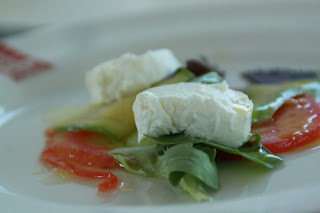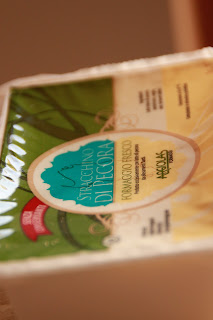Fiori di bresaola, Caprino Argiolas e pistacchi Flowers of bresaola, Argiolas Goat cheese and pistachios.
Quest’oggi un piatto saporito e nazionalista, la sua caratteristica sono i colori della bandiera italiana, il rosso della bresaola, il bianco del caprino ed il verde dei pistacchi. Perciò VIVA L’ITALIA e Buon appetito!!
Today a dish tasty and nationalist, in fact it's componed by the colors of the Italian flag, the red bresaola, the white goat cheese and the green of the pistachios. So VIVA L’ITALIA and enjoy!
I tre ingredienti principali The three main ingredients
Bresaola
La Bresaola è un salume a Indicazione Geografica Protetta (IGP), da carne di manzo, salata e stagionata, e viene consumato crudo.
Fonte: http://it.wikipedia.org/
Bresaola
Bresaola is a cured Protected Geographical Indication (PGI), from beef, salted and seasoned, and eaten raw.
Source: http://it.wikipedia.org/
Il Caprino Argiolas
Cremosi e ricchissimi di fermenti lattici, i Caprini Argiolas sono un prodotto fresco, sano e appetitoso.
The Goat cheese Argiolas
Creamy and rich in lactic acid bacteria Argiolas goat cheese have a fresh, healthy and appetizing.
I Pistacchi
La pianta del pistacchio appartiene alla famiglia delle Anacardiaceae, può raggiungere un'altezza che può superare i dieci metri ed è originaria del Medio Oriente; il suo nome scientifico è "Pistacia vera". Il frutto del pistacchio è un frutto secco dal caratteristico colore verde ed è racchiuso in un guscio rigido dall'aspetto legnoso; I principali paesi produttori di pistacchi sono l'Iran, la California e la Turchia; in Italia viene coltivato con successo in Sicilia dove troviamo i rinomati pistacchi del Bronte, cittadina in provincia di Catania, dove hanno acquisito il marchio D.O.P
Fonte: http://www.mr-loto.it/pistacchio.html
The Pistachios
The pistachio plant belongs to the family Anacardiaceae, can reach a height that can exceed ten meters and is native to the Middle East, and its scientific name is "Pistacia vera." The fruit of the pistachio nut is a dry fruit its characteristic green color and is encased in a hard shell looking wood, the main producer of pistachios are Iran, California and Turkey, in Italy it is grown successfully in Sicily where we find the famous Bronte pistachios, a town in the province of Catania, where they acquired the DOP certification
Source: http://www.mr-loto.it/pistacchio.html
Ingredienti Ingredients
200g di Bresaola 200g (7oz) of Bresaola
1 confezione di Rotolini di capra 1 package of Rotolini di Capra Argiolas (fresh goat cheese)
20 pistacchi 20 pistachios
Stuzzicadenti toothpick
Frammentare i pistacchi in tanti piccoli pezzetti
Cut the pistachios into small pieces
Con un coltello dividere i caprini in dischetti, ci dovrebbe essere un dischetto per ogni fetta di bresaola
Use a knife to divide the goats as little disks, there should be a disk for each slice of bresaola
Posizionare ogni dischetto di caprino su ciascuna fetta di bresaola, condire con un goccio d’olio ed una spolverata di pepe
Place each disk of goat cheese on each slice of Bresaola, season with a little oil and a sprinkling of pepper
Tagliare gli stuzzicadenti in due, chiudere la fetta di bresaola e fermare con mezzo stuzzicadenti formando dei piccoli fiorellini
Coprire con i pezzetti di pistacchio.
Cut the toothpicks in half, close the Bresaola slic and secure with half toothpicks forming small flowers
Cover with chopped pistachios.
























